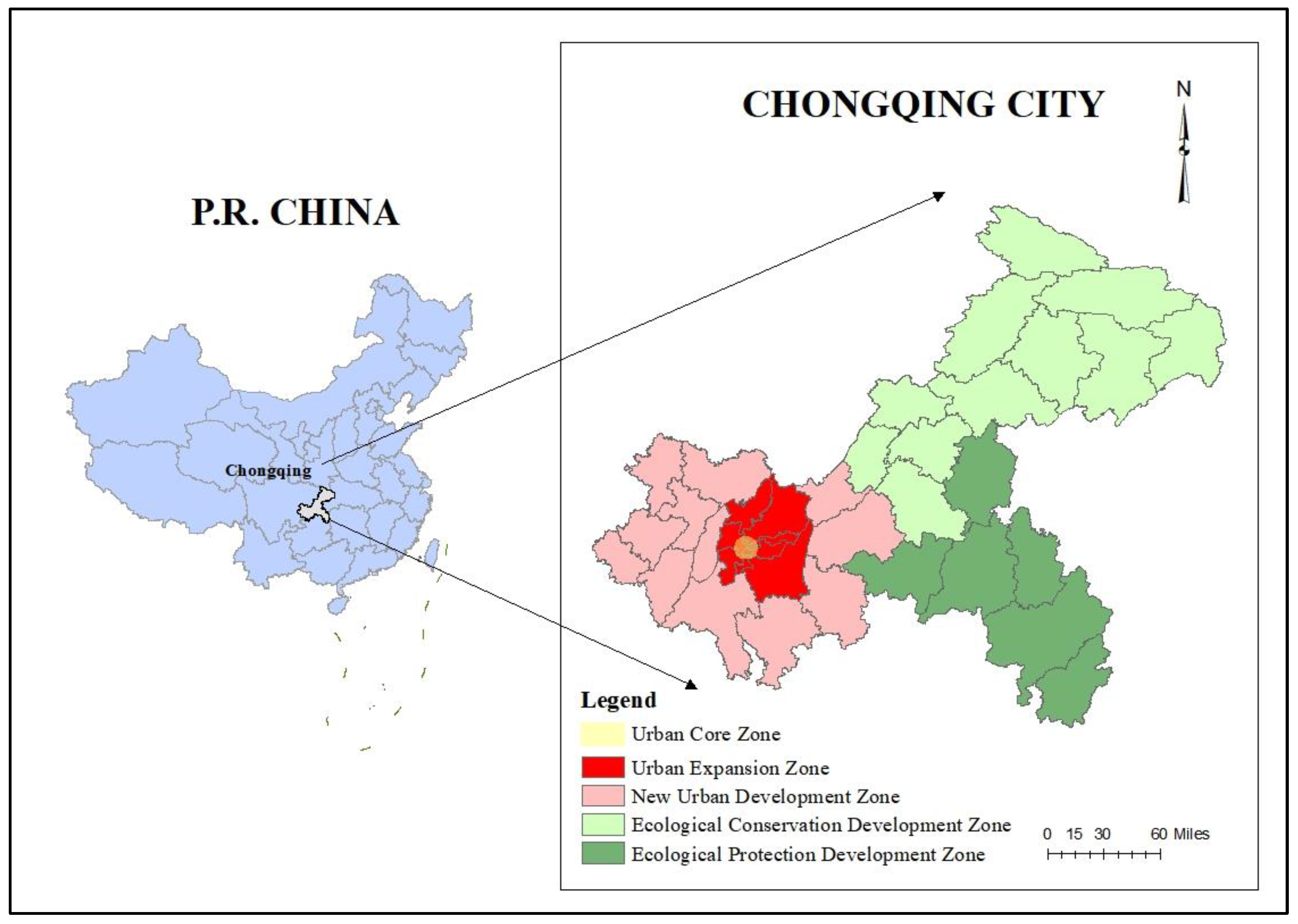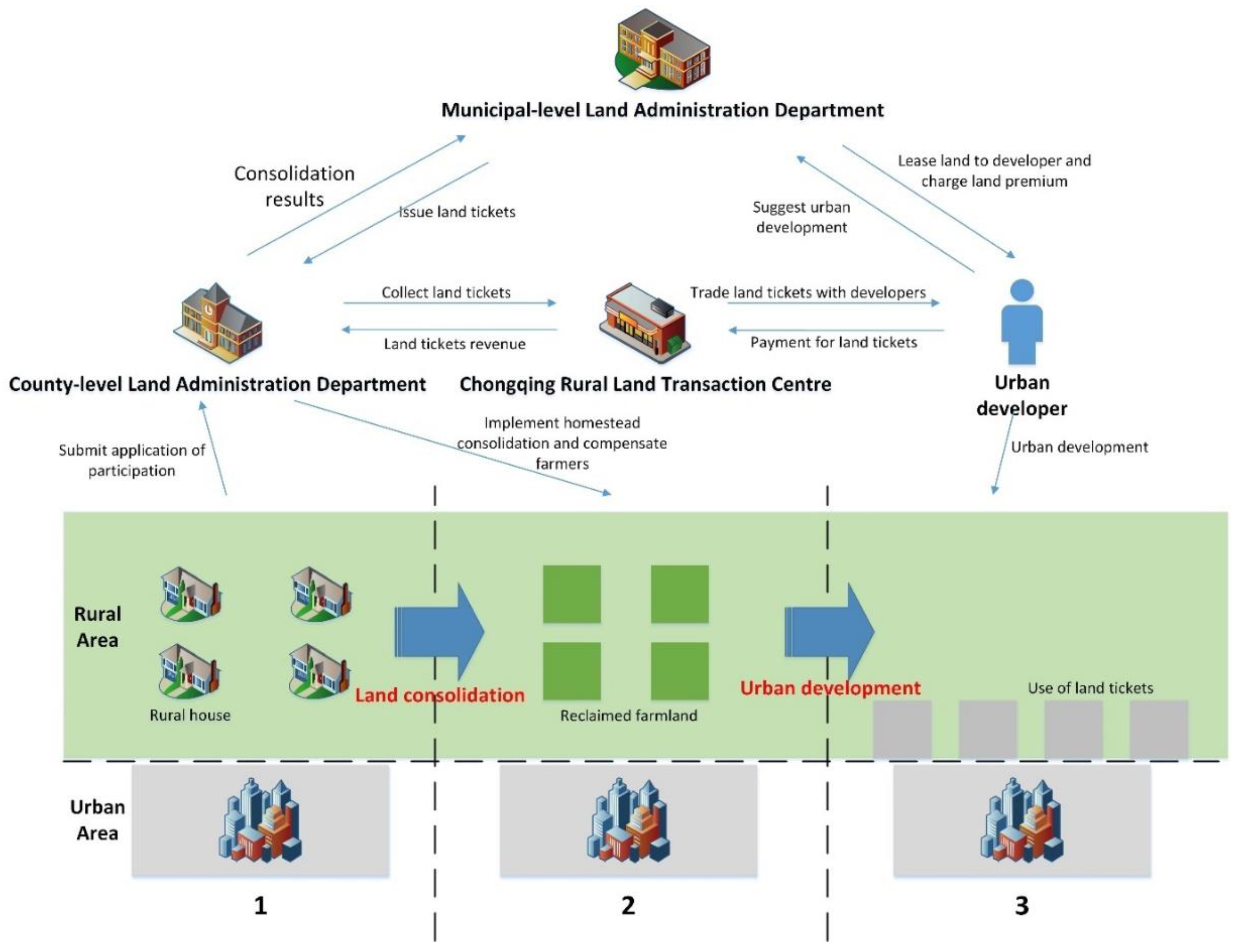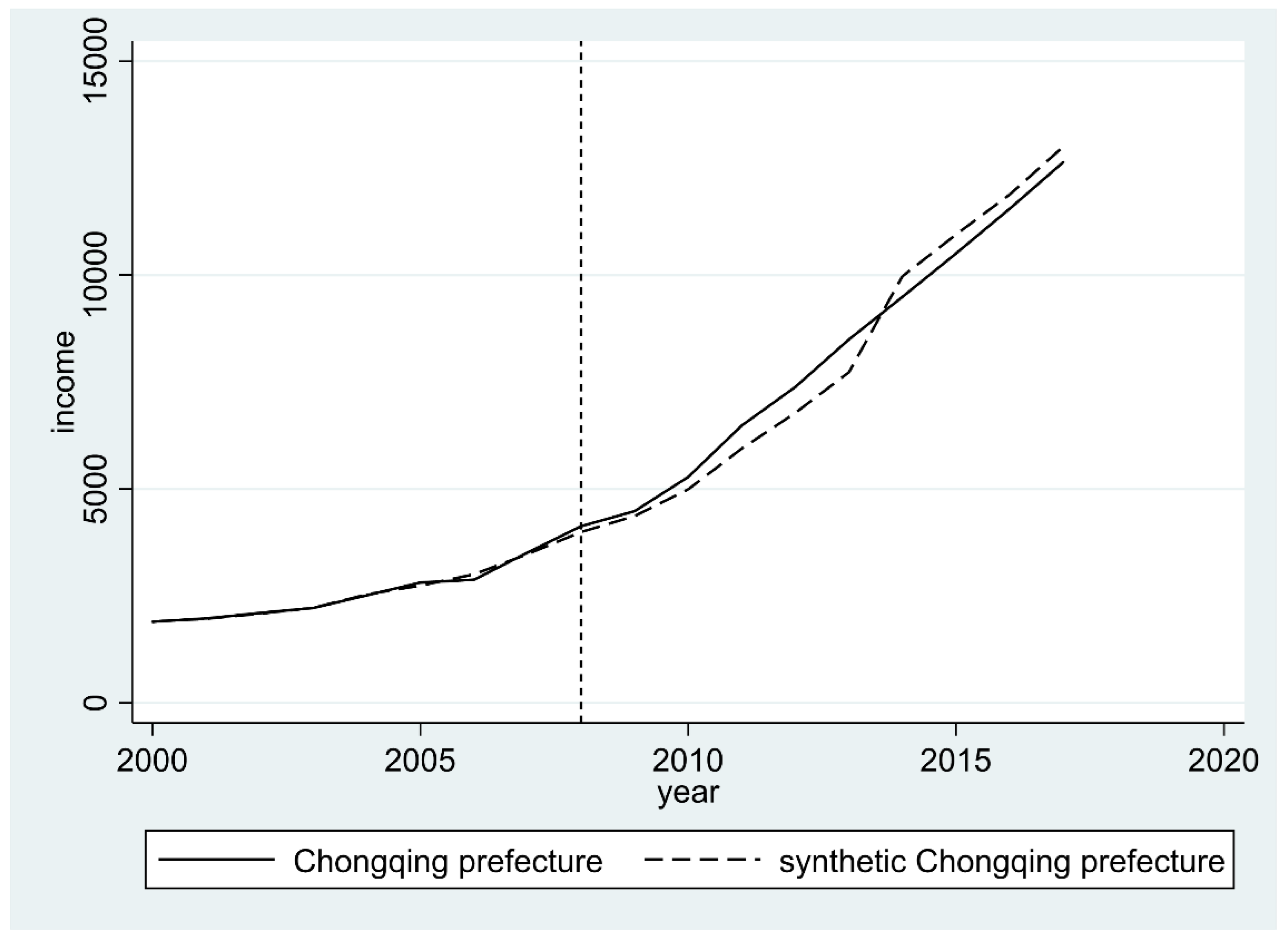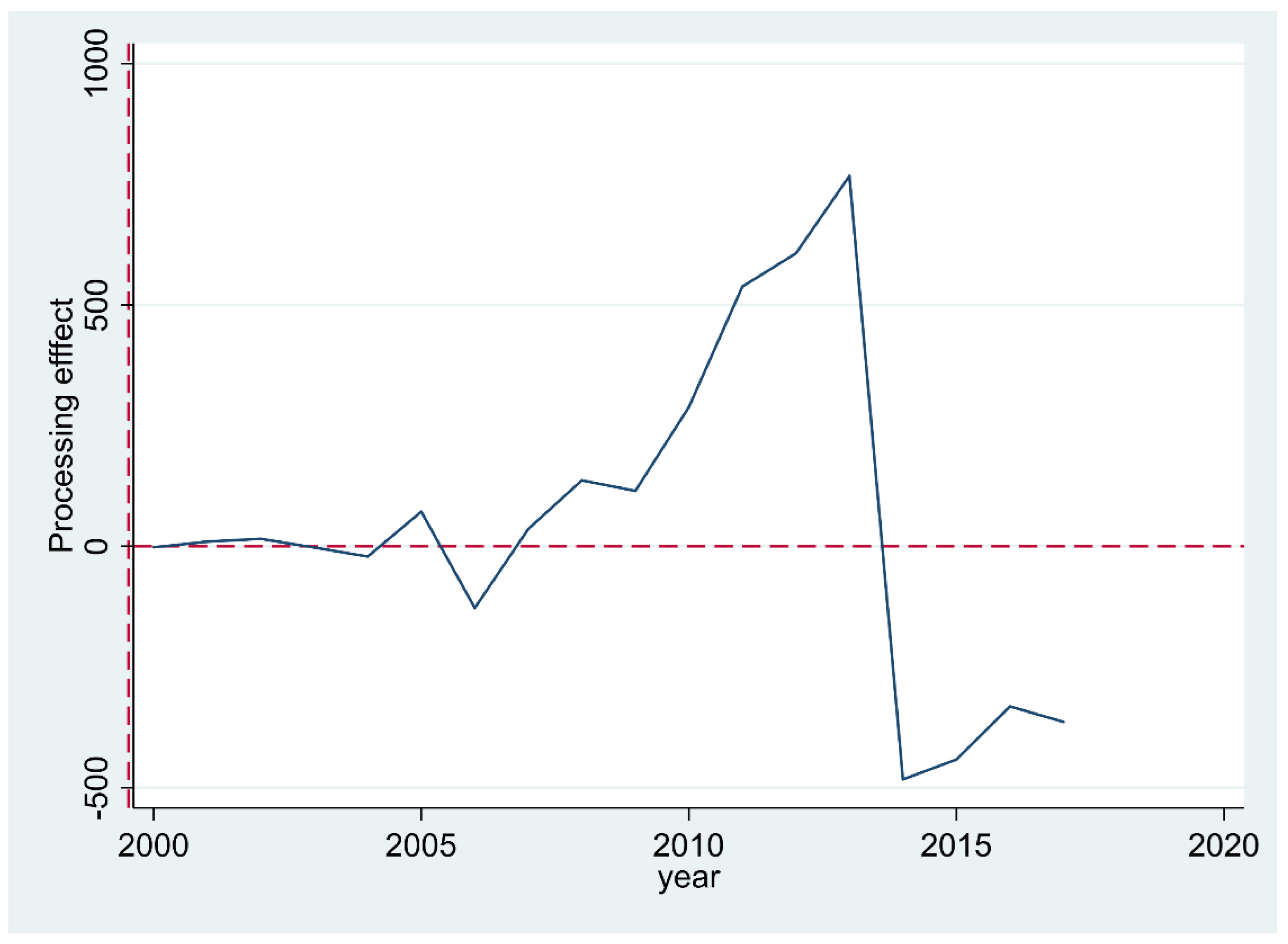Promote or Demote? Investigating the Impacts of China’s Transferable Development Rights Program on Farmers’ Income: A Case Study from Chongqing
Abstract
1. Introduction
2. Understanding the Chinese Version of the TDR Program: The Link Policy
2.1. The Proposal of the Link Policy
2.2. The Link Policy vs. Transferable Development Rights
2.3. The Link Policy in Chongqing: Land Ticket Program
3. Methodology
3.1. Data Collection and Description
3.2. Synthetic Control Method
4. Results
4.1. Modeling Results
4.2. Robustness Test and Placebo Test
5. Discussion and Policy Recommendations
5.1. Discussion for the Promotion Period (2008–2013)
5.2. Discussion for the Demotion Period (2014–2017)
5.3. Policy Recommendations
- (1)
- Corresponding to the issue of unreasonable distribution of proceeds, a fair and effective system for the distribution of proceeds from land tickets should be established. Farmers will participate in the initial distribution of the land ticket transaction and the distribution of the land premium when the land ticket is granted and will adjust the proportion of land ticket revenue in a fair and reasonable manner. At the same time, the price of land development rights is introduced, and the differential land rent premiums generated in the process of the land transaction are reasonably distributed between urban and rural areas, and between the land producing and using areas in accordance with the principle of “fairness and efficiency”, with a certain proportion of the premiums being used as a development fund for the rural areas where the land tickets are produced. A certain percentage of the land rent premium will be used as a development fund for rural economic organizations in the land where the land stamps are produced, so as to feed rural infrastructure construction.
- (2)
- Aiming to address the problem of insufficient income for farmers, a land reclamation guarantee mechanism and farmer skill training are needed. On the one hand, in conjunction with the industrial layout of the new socialist countryside, the reclaimed land should be incorporated into modern industrial construction to ensure that the reclaimed construction land can effectively create wealth for farmers in the long term, thereby increasing their income; on the other hand, the training of new skills of farmers should be strengthened to improve their livelihood skills after participation in the land ticket trading system, so as to lengthen the positive impact of the policy and to send them on their way.
- (3)
- Recommendations to address the issue of inconsistent standards of reclamation and improve the process of land reclamation are as follows: First, strengthen the qualification audit of third-party reclamation agencies, and strictly control technical standards to enhance the grade of reclaimed arable land. Second, make effective risk assessments of the reasonableness and necessity of construction land reclamation, raise the threshold for construction land reclamation and eliminate the phenomenon of reclamation for the sake of reclamation. Third, establish a sound monitoring and review mechanism, severely punish profit-seeking behavior and do a good job of looking back.
6. Conclusions
Author Contributions
Funding
Data Availability Statement
Acknowledgments
Conflicts of Interest
References
- Chen, M.; Liu, W.; Tao, X. Evolution and assessment on China’s urbanization 1960–2010: Under-urbanization or over-urbanization? Habitat Int. 2013, 38, 25–33. [Google Scholar] [CrossRef]
- Cohen, B. Urban Growth in Developing Countries: A Review of Current Trends and a Caution Regarding Existing Forecasts. World Dev. 2004, 32, 23–51. [Google Scholar] [CrossRef]
- Mosammam, H.M.; Nia, J.T.; Khani, H.; Teymouri, A.; Kazemi, M. Monitoring land use change and measuring urban sprawl based on its spatial forms: The case of Qom city. Egypt. J. Remote Sens. Space Sci. 2017, 20, 103–116. [Google Scholar] [CrossRef]
- Zhang, K.H. What Explains China’s Rising Urbanisation in the Reform Era? Urban Stud. 2016, 39, 2301–2315. [Google Scholar] [CrossRef]
- United Nations Population Fund. State of World Population 2007: Unleashing the Potential of Urban Growth; United Nations Population Fund: New York, NY, USA, 2007. [Google Scholar]
- United Nations Department of Economic and Social Affairs/Population Division. World urbanization prospects: The 2014 revision; United Nations Department of Economic and Social Affairs/Population Division: New York, NY, USA, 2015. [Google Scholar]
- UN HABITAT. World Cities Report 2020: The Value of Sustainable Urbanization. Available online: https://unhabitat.org/World%20Cities%20Report%202020 (accessed on 12 September 2022).
- Chan, K.W. Fundamentals of China’s urbanization and policy. China Rev. 2010, 10, 63–94. [Google Scholar]
- Zhang, L.; Zhao, S.X. Reinterpretation of China’s under-urbanization: A systemic perspective. Habitat Int. 2003, 27, 459–483. [Google Scholar] [CrossRef]
- Shen, J. Understanding dual-track urbanisation in post-reform China: Conceptual framework and empirical analysis. Popul. Space Place 2006, 12, 497–516. [Google Scholar] [CrossRef]
- Shen, J.F.; Wong, K.Y.; Feng, Z.Q. State-sponsored and spontaneous urbanization in the Pearl River Delta of south China, 1980-1998. Urban Geogr. 2002, 23, 674–694. [Google Scholar] [CrossRef]
- Wong, K.Y.; Shen, J.F.; Feng, Z.Q.; Gu, C.L. An analysis of dual-track urbanisation in the Pearl River Delta since 1980. Tijdschr. Voor Econ. En Soc. Geogr. 2003, 94, 205–218. [Google Scholar] [CrossRef]
- Cui, G.; Ma, L.J. Urbanization from below in China: Its development and mechanisms. Acta Geogr. Sin. 1999, 54, 113–115. [Google Scholar]
- Ma Laurence, J.C.; Fan, M. Urbanisation from Below: The Growth of Towns in Jiangsu, China. Urban Stud. 1994, 31, 1625–1645. [Google Scholar] [CrossRef]
- Ma, L.J.; Lin, C. Development of Towns in China: A Case Study of Guangdong Province. Popul. Dev. Rev. 1993, 19, 583–606. [Google Scholar] [CrossRef]
- Ministry of Housing and Urban-Rural Development of the People’s Republic of China. China Urban-Rural Construction Statistical Yearbook; Ministry of Housing and Urban-Rural Development of the People’s Republic of China: Beijing, China, 2019. [Google Scholar]
- Feng, W.; Liu, Y.; Qu, L. Effect of land-centered urbanization on rural development: A regional analysis in China. Land Use Policy 2019, 87, 104072. [Google Scholar] [CrossRef]
- Gu, C.; Hu, L.; Cook, I.G. China’s urbanization in 1949–2015: Processes and driving forces. Chin. Geogr. Sci. 2017, 27, 847–859. [Google Scholar] [CrossRef]
- Li, Y.; Jia, L.; Wu, W.; Yan, J.; Liu, Y. Urbanization for rural sustainability—Rethinking China’s urbanization strategy. J. Clean. Prod. 2018, 178, 580–586. [Google Scholar] [CrossRef]
- Deng, X.Z.; Huang, J.K.; Rozelle, S.; Zhang, J.P.; Li, Z.H. Impact of urbanization on cultivated land changes in China. Land Use Policy 2015, 45, 1–7. [Google Scholar] [CrossRef]
- Lichtenberg, E.; Ding, C. Assessing farmland protection policy in China. Land Use Policy 2008, 25, 59–68. [Google Scholar] [CrossRef]
- Ong, L.H. State-Led Urbanization in China: Skyscrapers, Land Revenue and “Concentrated Villages”. China Q. 2014, 217, 162–179. [Google Scholar] [CrossRef]
- Wang, J.; Lin, Y.; Glendinning, A.; Xu, Y. Land-use changes and land policies evolution in China’s urbanization processes. Land Use Policy 2018, 75, 375–387. [Google Scholar] [CrossRef]
- Lin, G.C.S. Understanding Land Development Problems in Globalizing China. Eurasian Geogr. Econ. 2010, 51, 80–103. [Google Scholar] [CrossRef]
- Long, H.L.; Li, Y.R.; Liu, Y.S.; Woods, M.; Zou, J. Accelerated restructuring in rural China fueled by ‘increasing vs. decreasing balance’ land-use policy for dealing with hollowed villages. Land Use Policy 2012, 29, 11–22. [Google Scholar] [CrossRef]
- Zhao, Q.Y.; Zhang, Z.L. Does China’s ‘increasing versus decreasing balance’ land-restructuring policy restructure rural life? Evidence from Dongfan Village, Shaanxi Province. Land Use Policy 2017, 68, 649–659. [Google Scholar] [CrossRef]
- Li, Y.R.; Liu, Y.S.; Long, H.L.; Cui, W.G. Community-based rural residential land consolidation and allocation can help to revitalize hollowed villages in traditional agricultural areas of China: Evidence from Dancheng County, Henan Province. Land Use Policy 2014, 39, 188–198. [Google Scholar] [CrossRef]
- Cheng, L.; Brown, G.; Liu, Y.; Searle, G. An evaluation of contemporary China’s land use policy—The Link Policy: A case study from Ezhou, Hubei Province. Land Use Policy 2020, 91, 104423. [Google Scholar] [CrossRef]
- Tang, Y.; Mason, R.J.; Wang, Y.B. Governments’ functions in the process of integrated consolidation and allocation of rural-urban construction land in China. J. Rural Stud. 2015, 42, 43–51. [Google Scholar] [CrossRef]
- Cheng, L.; Liu, Y.; Brown, G.; Searle, G. Factors affecting farmers’ satisfaction with contemporary China’s land allocation policy—The Link Policy: Based on the empirical research of Ezhou. Habitat Int. 2018, 75, 38–49. [Google Scholar] [CrossRef]
- Wen, L.-j.; Butsic, V.; Stapp, J.R.; Zhang, A.-l. Can China’s land coupon program activate rural assets? An empirical investigation of program characteristics and results of Chongqing. Habitat Int. 2017, 59, 80–89. [Google Scholar] [CrossRef]
- Yep, R.; Forrest, R. Elevating the peasants into high-rise apartments: The land bill system in Chongqing as a solution for land conflicts in China? J. Rural Stud. 2016, 47, 474–484. [Google Scholar] [CrossRef]
- Ye, Y.M.; LeGates, R.; Qin, B. Coordinated Urban-Rural Development Planning in China The Chengdu Model. J. Am. Plan. Assoc. 2013, 79, 125–137. [Google Scholar] [CrossRef]
- Cui, B. “Exchange Isolated Farmers’ Residential Land with Well-planned House”:A New Transfer Mode of Rural Collective Construction Land in Tianjin City. China Land Sci. 2010, 24, 37–40, 46. [Google Scholar]
- Wang, H.; Tao, R.; Wang, L.L.; Su, F.B. Farmland preservation and land development rights trading in Zhejiang, China. Habitat Int. 2010, 34, 454–463. [Google Scholar] [CrossRef]
- Wang, B.; Li, F.; Feng, S.Y.; Shen, T. Transfer of development rights, farmland preservation, and economic growth: A case study of Chongqing’s land quotas trading program. Land Use Policy 2020, 95, 17. [Google Scholar] [CrossRef]
- Li, J.; Lo, K.; Zhang, P.; Guo, M. Reclaiming small to fill large: A novel approach to rural residential land consolidation in China. Land Use Policy 2021, 109, 105706. [Google Scholar] [CrossRef]
- Gao, W.; de Vries, W.T.; Zhao, Q. Understanding rural resettlement paths under the increasing versus decreasing balance land use policy in China. Land Use Policy 2021, 103, 105325. [Google Scholar] [CrossRef]
- Chen, C.; Yu, L.; Choguill, C.L. “Dipiao”, Chinese approach to transfer of land development rights: The experiences of Chongqing. Land Use Policy 2020, 99, 104870. [Google Scholar] [CrossRef]
- Huang, X.; Li, Y.; Yu, R.; Zhao, X. Reconsidering the Controversial Land Use Policy of “Linking the Decrease in Rural Construction Land with the Increase in Urban Construction Land”: A Local Government Perspective. China Rev. 2014, 14, 175–198. [Google Scholar]
- Liu, R.Q.; Jiang, J.; Yu, C.; Rodenbiker, J.; Jiang, Y.M. The endowment effect accompanying villagers’ withdrawal from rural homesteads: Field evidence from Chengdu, China. Land Use Policy 2021, 101, 14. [Google Scholar] [CrossRef]
- Huang, Y.; Zhang, C.; Liu, W. Who drives the formation and adoption of the “increasing versus decreasing balance policy”?—Evidence from a policy process analysis. Land Use Policy 2019, 80, 175–184. [Google Scholar] [CrossRef]
- Cheng, L. Contemporary China’s Land Use Policy, 1st ed.; Springer: Singapore, 2021. [Google Scholar]
- Cheng, L. China’s rural transformation under the Link Policy: A case study from Ezhou. Land Use Policy 2021, 103, 105319. [Google Scholar] [CrossRef]
- Li, Y.; Li, Y.; Westlund, H.; Liu, Y. Urban–rural transformation in relation to cultivated land conversion in China: Implications for optimizing land use and balanced regional development. Land Use Policy 2015, 47, 218–224. [Google Scholar] [CrossRef]
- Chien, S.-S. Local farmland loss and preservation in China—A perspective of quota territorialization. Land Use Policy 2015, 49, 65–74. [Google Scholar] [CrossRef]
- Cheng, H.; Shaw, D. Polycentric development practice in master planning: The case of China. Int. Plan. Stud. 2018, 23, 163–179. [Google Scholar] [CrossRef]
- Zhou, Y.; Huang, X.J.; Chen, Y.; Zhong, T.Y.; Xu, G.L.; He, J.L.; Xu, Y.T.; Meng, H. The effect of land use planning (2006–2020) on construction land growth in China. Cities 2017, 68, 37–47. [Google Scholar] [CrossRef]
- Zhou, Y.; Huang, X.; Zhong, T.; Chen, Y.; Yang, H.; Chen, Z.; Xu, G.; Niu, L.; Li, H. Can annual land use plan control and regulate construction land growth in China? Land Use Policy 2020, 99, 105026. [Google Scholar] [CrossRef]
- Cheng, L. China’s Rural Transformation and The Link Policy. In Contemporary China’s Land Use Policy: The Link Policy; Springer: Singapore, 2021; pp. 27–57. [Google Scholar]
- Liu, T.; Lin, G.C.S. New geography of land commodification in Chinese cities: Uneven landscape of urban land development under market reforms and globalization. Appl. Geogr. 2014, 51, 118–130. [Google Scholar] [CrossRef]
- Cheng, L. To leave or not to leave? ‘Intention’ is the question. Investigating farmers’ decision behaviours of participating in contemporary China’s rural resettlement programme. Environ. Impact Assess. Rev. 2022, 97, 106888. [Google Scholar] [CrossRef]
- Deng, F. Land development right and collective ownership in China. Post-Communist Econ. 2013, 25, 190–205. [Google Scholar] [CrossRef]
- Hui, E.C.M.; Bao, H. The logic behind conflicts in land acquisitions in contemporary China: A framework based upon game theory. Land Use Policy 2013, 30, 373–380. [Google Scholar] [CrossRef]
- Johnston, R.A.; Johnston, R.A.; Madison, M.E.; Madison, M.E. From landmarks to landscapes: A review of current practices in the transfer of development rights. J. Am. Plan. Assoc. 1997, 63, 365–378. [Google Scholar] [CrossRef]
- Wang, J.; Wu, Q.; Yan, S.; Guo, G.; Peng, S. China’s local governments breaking the land use planning quota: A strategic interaction perspective. Land Use Policy 2020, 92, 104434. [Google Scholar] [CrossRef]
- McConnell, V.; Walls, M.; Kopits, E. Zoning, TDRs and the density of development. J. Urban Econ. 2006, 59, 440–457. [Google Scholar] [CrossRef]
- Machemer, P.L.; Kaplowitz, M.D. A framework for evaluating transferable development rights programmes. J. Environ. Plan. Manag. 2002, 45, 773–795. [Google Scholar] [CrossRef]
- Goelman, A. Transferable Development Rights: A Policy Analysis of a Planning Instrument and Its Application in Vancouver; University of British Columbia: Vancouver, BC, Canada, 1999. [Google Scholar]
- Han, S.S.; Lin, W. Transforming rural housing land to farmland in Chongqing, China: The land coupon approach and farmers’ complaints. Land Use Policy 2019, 83, 370–378. [Google Scholar] [CrossRef]
- Chongqing Land Rural Exchange. Land Quota Market Operation Analysis Report 2017. Available online: https://www.cquae.com/ (accessed on 12 September 2022).
- Ke, L.; Li, C.; Wang, X.; Li, Y.; Chen, D. Research on the Impact of Land Circulation Policy on the Income of Regional Farmers—Empirical Evidence from Hunan Province. China Land Sci. 2019, 33, 53–62. [Google Scholar]
- Abadie, A.; Diamond, A.; Hainmueller, J. Comparative Politics and the Synthetic Control Method. Am. J. Political Sci. 2015, 59, 495–510. [Google Scholar] [CrossRef]
- Abadie, A.; Diamond, A.; Hainmueller, J. Synthetic Control Methods for Comparative Case Studies: Estimating the Effect of California’s Tobacco Control Program. J. Am. Stat. Assoc. 2010, 105, 493–505. [Google Scholar] [CrossRef]
- Abadie, A.; Gardeazabal, J. The economic costs of conflict: A case study of the Basque country. Am. Econ. Rev. 2003, 93, 113–132. [Google Scholar] [CrossRef]
- Liu, Y.; Zeng, X. The impact of property tax on industrial transfer: Empirical evidence from Chongqing and Shanghai. China Ind. Econ. 2018, 11, 98–116. [Google Scholar]






| Variable | Description | Source |
|---|---|---|
| Farmers’ income | Total amount of money that farmers can use for consumption and savings | China Statistical Yearbook and Statistical Yearbooks of four selected provinces |
| Rural mechanization level | Total power of agricultural machines divided by rural population | Statistical Yearbooks of four provinces and the Provincial and Municipal Statistics Bureau |
| Farmers’ average farmland | The overall farmland divided by the rural population | China Statistical Yearbook and Statistical Yearbooks of four provinces |
| Average financial expenditure | General public expenditure divided by the total area | China Statistical Yearbook and Statistical Yearbooks of four provinces |
| Per capita highway mileage | Total rural road mileage divided by the rural population | China Statistical Yearbook and Statistical Yearbooks of four provinces |
| Per capita electricity consumption | Rural electricity consumption divided by the rural population | China Statistical Yearbook and Statistical Yearbooks of four provinces |
| Variable | Policy Group Mean | No Policy Group Mean | Mean Difference |
|---|---|---|---|
| Panel A (2000–2017) | |||
| Farmers’ income (CNY) | 5572.087 | 6083.614 | −511.527 |
| Rural mechanization level (KW) | 0.457 | 0.808 | −0.351 |
| Farmers’ average farmland (Hectares) | 0.095 | 0.093 | 0.002 |
| Average financial expenditure (Ten thousand CNY per hectare) | 3.147 | 1.808 | 1.339 |
| Per capita highway mileage (Meters) | 3.259 | 2.548 | 0.711 |
| Per capita electricity consumption (KW/h) | 282.694 | 256.935 | 25.759 |
| Panel B (2000–2007) | |||
| Farmers’ income (CNY) | 2484.825 | 2793.631 | −308.306 |
| Rural mechanization level (KW) | 0.303 | 0.487 | −0.184 |
| Farmers’ average farmland (Hectares) | 0.082 | 0.081 | 0.001 |
| Average financial expenditure (Ten thousand CNY per hectare) | 0.614 | 0.450 | 0.164 |
| Per capita highway mileage (Meters) | 2.041 | 1.580 | 0.461 |
| Per capita electricity consumption (KW/h) | 156.605 | 180.097 | −23.492 |
| Panel C (2008–2017) | |||
| Farmers’ income (CNY) | 8041.897 | 8715.600 | −673.703 |
| Rural mechanization level (KW) | 0.580 | 1.060 | −0.48 |
| Farmers’ average farmland (Hectares) | 0.105 | 0.102 | 0.003 |
| Average financial expenditure (Ten thousand CNY per hectare) | 5.151 | 2.894 | 2.257 |
| Per capita highway mileage (Meters) | 4.232 | 3.329 | 0.903 |
| Per capita electricity consumption (KW/h) | 383.565 | 319.381 | 64.184 |
| Predictor Variable | Real Value | Composite Value | Difference Value |
|---|---|---|---|
| Rural mechanization level (KW) | 0.303 | 0.304 | −0.001 ** |
| Farmers’ average farmland (Hectares) | 0.082 | 0.082 | 0.000 ** |
| Average financial expenditure (Ten thousand CNY per hectare) | 0.641 | 0.454 | 0.187 ** |
| Per capita highway mileage (Meters) | 2.041 | 2.04 | −0.03 ** |
| Per capita electricity consumption (KW/h) | 156.605 | 157.055 | −0.45 ** |
| Farmers’ income (CNY) (2000) | 1892.44 | 1901.996 | −9.556 ** |
| Farmers’ income (CNY) (2003) | 2214.55 | 2217.611 | −3.061 ** |
| Farmers’ income (CNY) (2007) | 3509.29 | 3473.323 | 35.677 ** |
| Province | Variable | Farmers’ Income (CNY) | Province | Variable | Farmers’ Income (CNY) |
|---|---|---|---|---|---|
| Area | Area | ||||
| Hunan (14) | Changsha | 0 | Yibin | 0 | |
| Zhuzhou | 0 | Guang’an | 0 | ||
| Xiangtan | 0 | Dazhou | 0 | ||
| Hengyang | 0 | Ya’an | 0 | ||
| Shaoyang | 0 | Bazhong | 0 | ||
| Yueyang | 0 | Ziyang | 0.317 | ||
| Changde | 0 | Hubei (12) | Wuhan | 0 | |
| Zhangjiajie | 0 | Huangshi | 0.022 | ||
| Yiyang | 0 | Shiyan | 0.285 | ||
| Chenzhou | 0 | Yichang | 0.037 | ||
| Yongzhou | 0 | Xiangyang | 0 | ||
| Huaihua | 0 | Ezhou | 0 | ||
| Loudi | 0 | Jingmen | 0 | ||
| Xiangxi | 0 | Xiaogan | 0 | ||
| Sichuan (18) | Chengdu | 0.102 | Jingzhou | 0 | |
| Zigong | 0 | Huanggang | 0.189 | ||
| Panzhihua | 0 | Xianning | 0 | ||
| Luzhou | 0 | Suizhou | 0 | ||
| Deyang | 0 | Guizhou (5) | Guiyang | 0 | |
| Mianyang | 0 | Zunyi | 0 | ||
| Guangyuan | 0 | Liupanshui | 0.049 | ||
| Suining | 0 | Anshun | 0 | ||
| Neijiang | 0 | Bijie | 0 | ||
| Leshan | 0 | Total | 49 | ||
| Nanchong | 0 | Matched prefectures | 7 | ||
| Meishan | 0 | Total weights | 1 | ||
Publisher’s Note: MDPI stays neutral with regard to jurisdictional claims in published maps and institutional affiliations. |
© 2022 by the authors. Licensee MDPI, Basel, Switzerland. This article is an open access article distributed under the terms and conditions of the Creative Commons Attribution (CC BY) license (https://creativecommons.org/licenses/by/4.0/).
Share and Cite
Cheng, L.; Xu, Z.; Li, J. Promote or Demote? Investigating the Impacts of China’s Transferable Development Rights Program on Farmers’ Income: A Case Study from Chongqing. Int. J. Environ. Res. Public Health 2022, 19, 13751. https://doi.org/10.3390/ijerph192113751
Cheng L, Xu Z, Li J. Promote or Demote? Investigating the Impacts of China’s Transferable Development Rights Program on Farmers’ Income: A Case Study from Chongqing. International Journal of Environmental Research and Public Health. 2022; 19(21):13751. https://doi.org/10.3390/ijerph192113751
Chicago/Turabian StyleCheng, Long, Zhengchun Xu, and Jintao Li. 2022. "Promote or Demote? Investigating the Impacts of China’s Transferable Development Rights Program on Farmers’ Income: A Case Study from Chongqing" International Journal of Environmental Research and Public Health 19, no. 21: 13751. https://doi.org/10.3390/ijerph192113751
APA StyleCheng, L., Xu, Z., & Li, J. (2022). Promote or Demote? Investigating the Impacts of China’s Transferable Development Rights Program on Farmers’ Income: A Case Study from Chongqing. International Journal of Environmental Research and Public Health, 19(21), 13751. https://doi.org/10.3390/ijerph192113751







